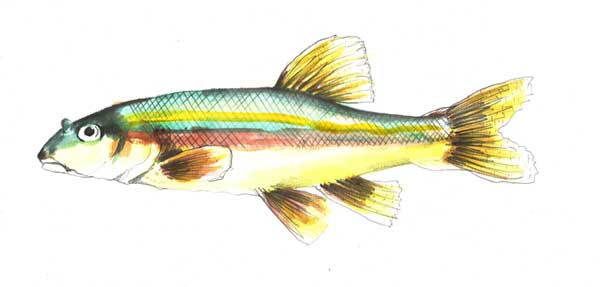
Dace (Leuciscus leuciscus)
Current record: 1lb 5oz 2dr
Water: River Wear, Town centre stretch, Durham
The dace, a member of the carp family Cyprinidae, encompasses several species of small to medium-sized freshwater fish found in rivers and streams across North America, Europe, and Asia. Known for their sleek and streamlined bodies, dace species typically exhibit a silver or golden coloration, making them visually appealing to observers. One commonly known species is the European dace (Leuciscus leuciscus), native to rivers and lakes in Europe, where it is often found in clear, flowing waters.
Dace are schooling fish, often congregating in large groups near the surface of the water. This behavior helps protect them from predators and enhances their ability to forage for small invertebrates, aquatic insects, and plant matter. The dace's diet is primarily composed of these items, making them important contributors to the balance of aquatic ecosystems as they regulate insect populations and participate in nutrient cycling.
Due to their modest size and abundance, dace are not typically the primary target for anglers, but they provide an essential food source for larger predatory fish and birds. Anglers who pursue dace often use small hooks and baits to catch them, appreciating the challenge these agile fish present. Additionally, dace play a role in scientific research as indicators of water quality, as their presence and abundance can reflect the health of aquatic environments.
In terms of conservation, dace are generally adaptable and resilient to various environmental conditions. However, like many freshwater species, they face threats from habitat degradation, pollution, and alterations to water flow. Conservation efforts focus on maintaining and restoring the health of rivers and streams through measures such as habitat restoration, pollution control, and sustainable water management practices.
The ecological significance of dace lies in their contribution to the overall health and functioning of freshwater ecosystems. By understanding their behavior, habitat requirements, and role in nutrient cycling, conservationists and researchers work to ensure the long-term survival of dace populations and the ecosystems they inhabit.
The common dace inhabits rivers, streams, and occasionally lakes or the brackish water at river mouths. It is a surface-dwelling fish that congregates in adult shoals in the backwaters and lower reaches of rivers throughout the winter. Some adults spend the entire winter upstream on the spawning grounds. In March and April, when it's time to spawn, they move upstream to lay their light yellow eggs on shallow gravel beds in swiftly moving streams. The eggs adhere to the gravel and stones.
When they reach maturity, the youngsters move into water with quicker currents after hiding among the bankside vegetation's cavities and roots. Small invertebrates are the common dace's primary food source.